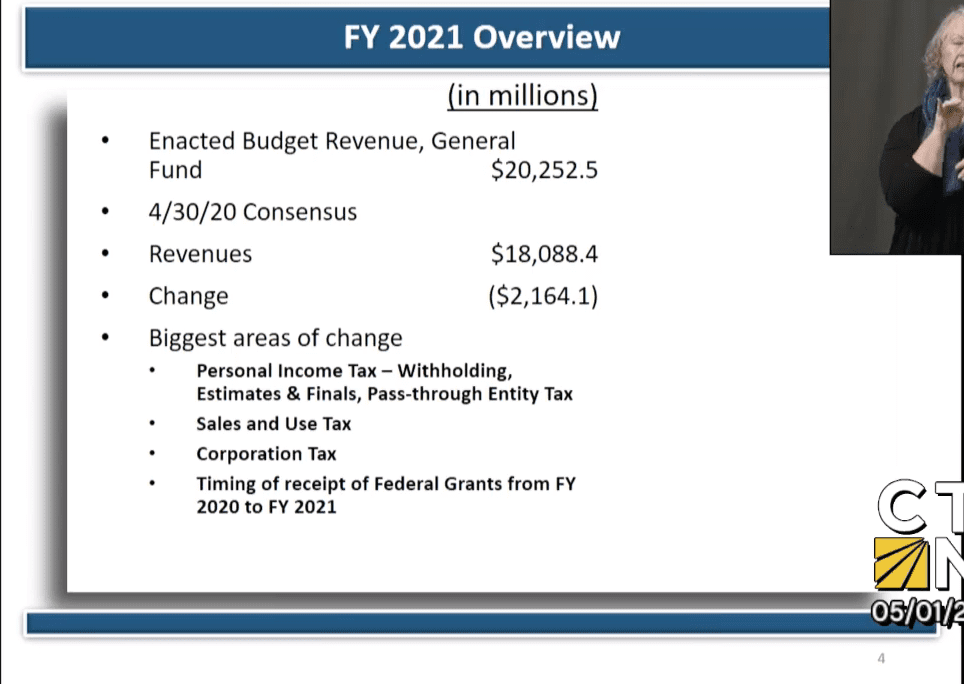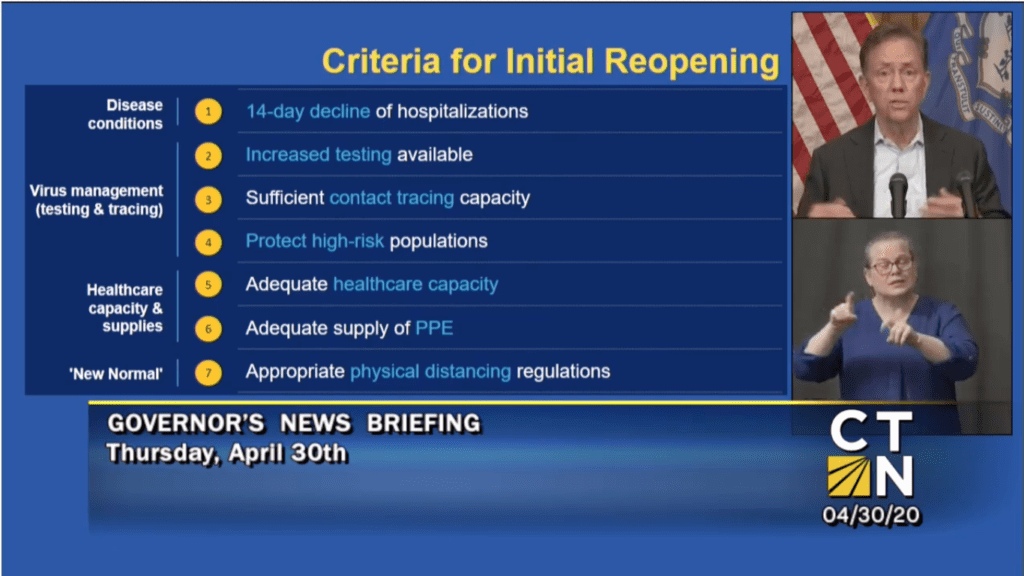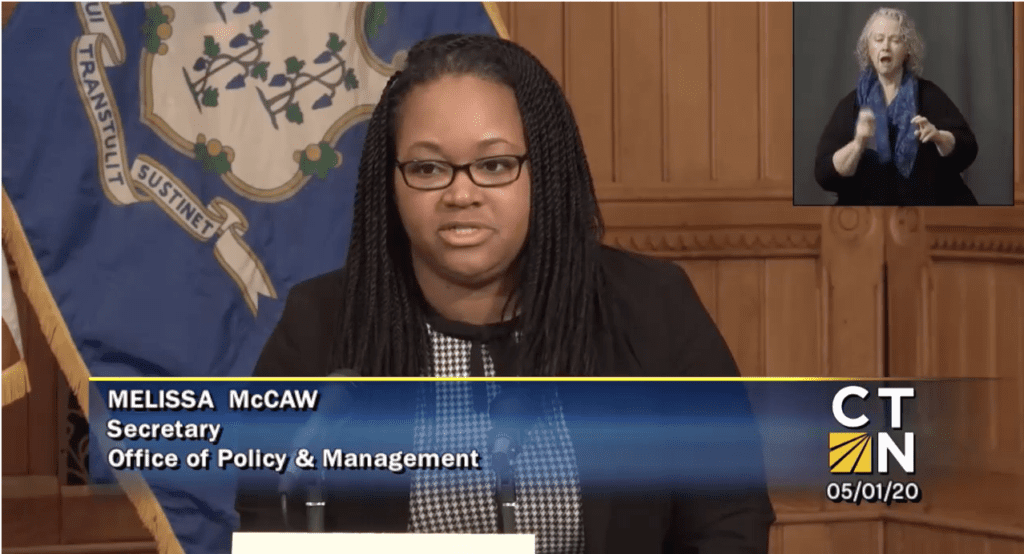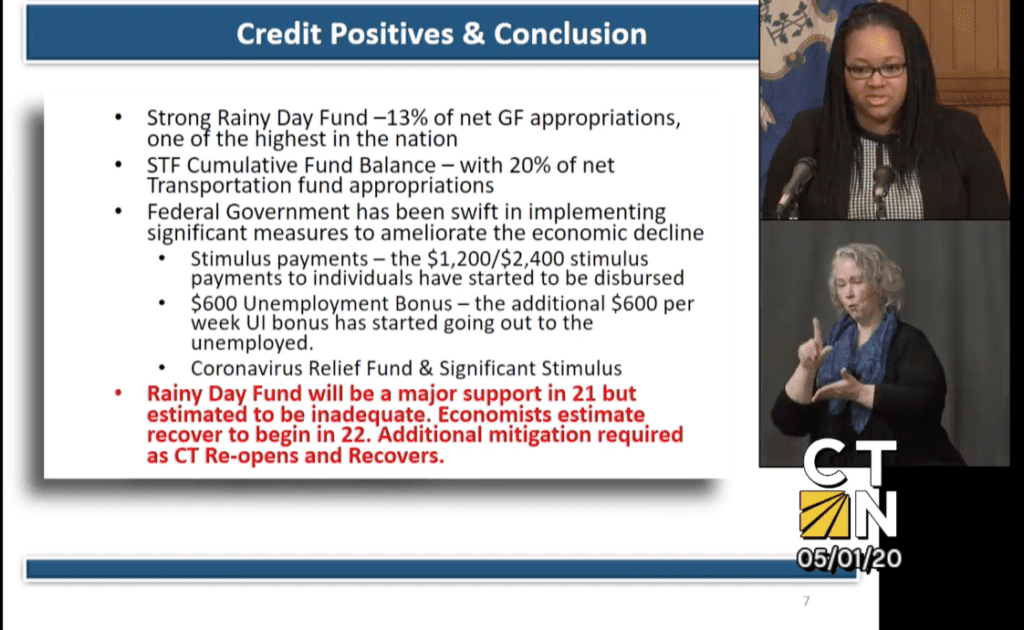Governor Ned Lamont announced a four-phase reopening plan beginning May 20 in hopes of capturing increased sales and income tax revenues as the state faces a $934 million deficit in fiscal year 2020 and a projected $2.2 billion deficit in fiscal year 2021 caused by efforts to control the spread of COVID-19.

“The numbers are sobering,” Lamont said, leading off a Friday morning press conference. “COVID has been tough on our physical health, mental health and fiscal health. The state was on track and doing well on budget until a couple months ago.”
In addition to significant declines in personal income tax revenue, which fell by 3.7 percent in March alone, Connecticut has seen and expects to see more declines in sales and use taxes, corporation taxes and the special transportation fund. In addition, an expected $370 million federal grant will be delayed until fiscal year 2021.

The phased reopening will still depend on the state’s ability to meet a threshold of 42,000 weekly tests for COVID-19, its ability to organize a contact tracing system and for hospitalizations to decline for an additional week.
A high bar for reopening
Lamont made clear in his Thursday press conference that May 20 is by no means a firm date for rolling back restrictions put in place to slow the spread of the coronavirus.
42,000 tests per week — or 6,000 tests per day statewide — is three times the number of tests being performed currently, according to Dr. Albert Ko, an epidemiologist at Yale School of Public Health and co-chair of the Reopen Connecticut Advisory Committee, and would allow the state to quickly pinpoint if and where infection rates are beginning to increase again.
“We are all working toward implementing testing very quickly. We need to be able to know if infection rates begin to increase again what the trigger is,” said Ko.

The additional testing sites will be concentrated in urban, lower-income areas where individuals live closer together and COVID-19 is more likely to spread or already be spreading. As testing increases the number of positive cases in the state is likely to increase significantly, but Ko said that should not be alarming because so many with COVID-19 are asymptomatic and untested.
“We will be drilling down to a look at numbers every day,” he said. “We need to know if it is a new outbreak and spreading or not.”
If minimum testing and tracing thresholds are met, the first phase of reopening will begin on May 20 with open air restaurants, retail stores, hair and nail salons, outdoor museums and zoos, outdoor recreation, university research programs and offices that require in-person work
“From the industries on the May 20 list, it’s about 30 percent of those who are currently unemployed that could go back to work,” said Josh Geballe, the chief operating officer for the state of Connecticut. “But they won’t be going back to full staffing right away, so it will likely be a bit less.”

Even if all the metrics are met and the first phase of industries are able to reopen, their success will depend on the comfort level of consumers to return both to public spaces and previous spending habits while still following social distancing protocols.
“Consumers will vote with their feet if they think stores are opening too soon,” Lamont said. “My instinct is that the consumer is going to get back slowly. I thought maybe there was pent up demand, but we are not seeing that in other states that have reopened.”
Whether the first phase of reopening significantly boosts the economy in Connecticut is yet to be seen.

“Our growth rate is going to depend on the timing it takes for individuals to be reemployed, businesses to reopen and the extent to which consumers feel comfortable spending at prior levels,” said Melissa McCaw, secretary of the Office of Policy and Management.
Reopening could stretch until 2021
With phase one potentially starting on May 20, the second phase could start as early as June 17 as the advisory committee has established a minimum of four weeks between each phase. The Reopen Connecticut Advisory Committee made it clear that a four week separation between each phase was aspirational, but unlikely. The time frame could easily be extended.
“We will learn so much with phase one and as our learning improves we can make better decisions about phase 2, 3 and 4,” said Indra Nooyi, the former CEO of PepsiCo and co-chair of the Reopen Connecticut Advisory Committee. “It is too early to ask about high contact venues where people come from out of state.”
It’s also too early to make decisions about schools, prisons, casinos, events and places of worship, according to Nooyi and Lamont. And too early to gauge how the average resident of Connecticut will respond to the reopening efforts.

“Will they start going back on the first day, no, but do I hope they will within 3 months, yes,” Lamont said. “We are giving permission, but every merchant and consumer is going to make their own decision.”
One thing is certain, according to state officials, each phase of the reopening will be implemented on a statewide rather than regional basis.
“We live in a highly interconnected state and region and we need to make sure the source of the infection is being controlled,” Lamont said. “We are coordinating with our neighboring states as well.”
Officials made clear that Fairfield County will reopen on the same schedule as New London County.
The fiscal impact
The federal government has already provided some aid to Connecticut for the unexpected expense of the virus this fiscal year. In addition to a 6 percent increase in Medicaid reimbursement, stimulus checks and weekly $600 unemployment supplements, the state received $1.4 billion to reimburse COVID-related expenses that were not included in the original 2020 budget.
For non-COVID expenses, the state has been heavily relying on its $1.9 billion rainy day fund to cover gaps in revenue this fiscal year caused by decreased tax revenues

“Connecticut’s rainy-day fund covered 13 percent of typical revenues, one of the highest rainy-day funds in the nation,” McCaw said. “We will require some additional mitigation to close the fiscal year in balance and some amount of revenue changes, but we are in a pretty good place compared to other states.”
Revenue changes will likely include holding current tax rates flat instead of providing previously proposed tax reductions.
“One example of a revenue change would be the proposed corporate 10 percent surcharge tax cut. That might be an item that we keep the same,” McCaw said. “The goal is not to damage our tax constituents … these will be customized conversations we will have with our legislative partners.”
In addition, because of a steady decline in gasoline prices and use, the special transportation fund has been further drawn down, raising the possibility that Lamont will bring the question of tolls back to the table in a special session this June.
“Maybe we can sit down with the legislature to shore up our special transportation fund,” Lamont said. “We have a year to do it and we ought to do it right and we ought to do it together … I think you have an idea of what I thought was appropriate. This is one of those problems that we can’t afford to keep kicking down the road.”

Although a week ago many legislators thought a special session this summer seemed unlikely, on Friday, Lamont appeared confident that a special session of the legislature would be held this June.
“We need a special session to act upon a deficiency bill as well as small tax policy changes to hold the line at the current tax rates,” he said. “We will be putting a small package in front of them at the very least.”
Although 2020 and 2021 fiscal year deficits are startling, McCaw said she is optimistic that the economic recovery will begin as soon as July 2021 and proceed much more rapidly than it did post the 2008 recession.
“Our economists project that it will be a v-shaped recovery,” she said. “A much quicker rebound compared to 2008.”

